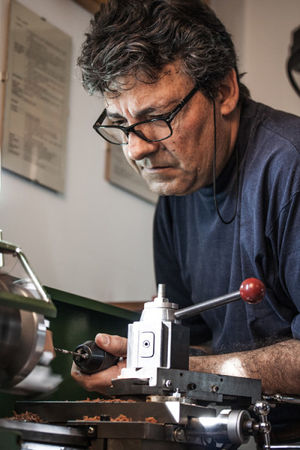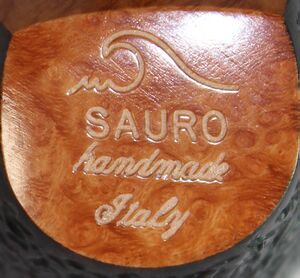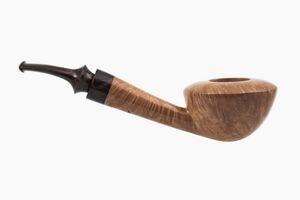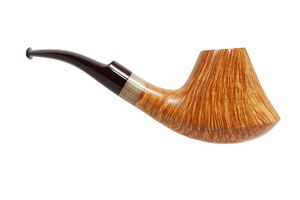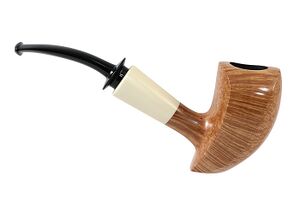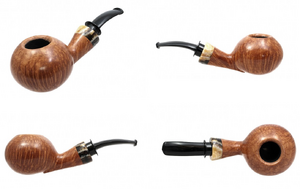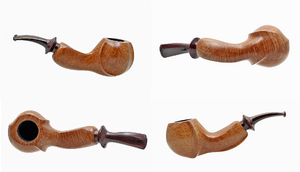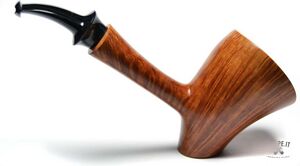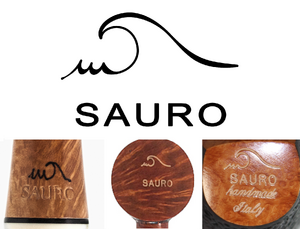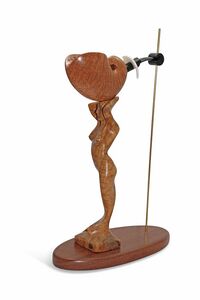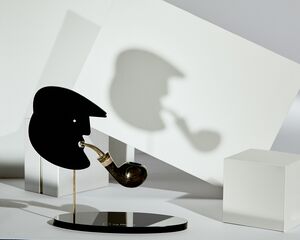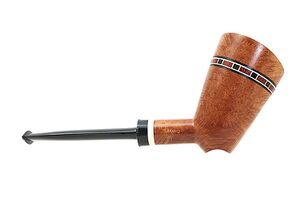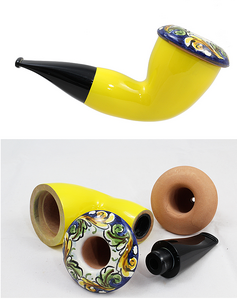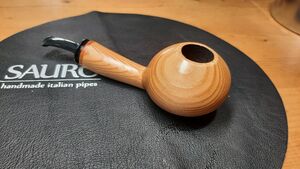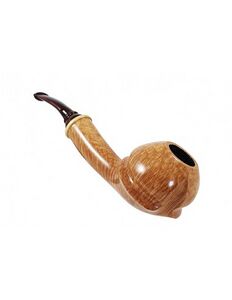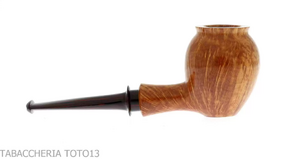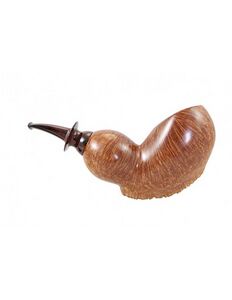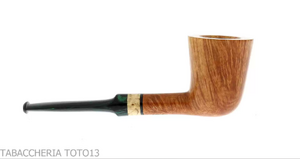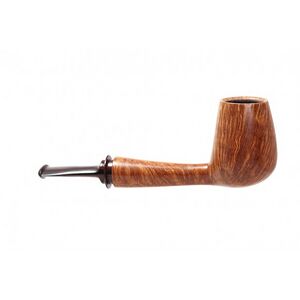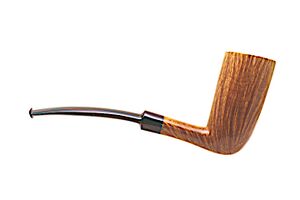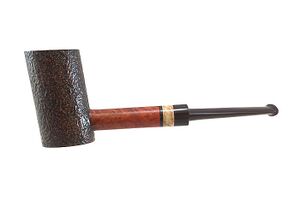Sauro Pipe
Sauro pipes are made by Gioacchino Sauro (b. 1959) in his workshop in Palermo, Sicily. Prior to becoming a pipe maker, Sauro worked as an agricultural scientist at the University of Palermo; in agricultural communications; and in Sicily’s Regional Phytosanitary Service.[1]
Biography
Sauro took up pipe making in 2011, after being encouraged to do so by his friend Carlo Riggio. Riggio was at this time the owner of Palermo’s historic Tabaccheria Riggio,[2] whose wares include, among other things, high-grade artisan pipes. Through his discussions with Riggio, as well as through books and online media on the subject, Sauro received his first education in pipe making. After some time, Riggio, pleased with Sauro’s skills and progress, nonetheless advised the latter that if he intended to advance further, he would have to find a master to study under.
To this end, in 2012, Sauro contacted Mimmo Romeo. In Sauro’s words,
“I sent him an email presentation with photos of my pipes. As is his style, he had no qualms about telling me that they ‘sucked.’ It was my wife Maria who lifted me out of my despair and insisted that I write to him again to ask what was wrong with my pipes… I can't say whether it was chance or fate, but Mimmo convinced himself to invite me to his workshop for a day.”
Evidently, Sauro was able to dispel Romeo’s doubts about his potential and was given the chance to continue as an apprentice in Romeo’s workshop. Here he met Brazilian pipe maker Eder Mathias, whose approach to pipe making also left a strong impression on Sauro’s burgeoning craft.
Sauro participated in his first pipe show at the Chicago Pipe Show in 2014. All of the pipes Sauro had taken with him were bought up by a dealer for the emerging Chinese high-end pipe market. The same year, Sauro, along with Romeo, visited the workshop of Tom Eltang as part of a celebration of Eltang’s 40th anniversary as a pipe maker.
In 2016, Sauro was contacted by Hamed Owlani, owner of the high-end pipe store Pipes Art. Pipes Art was the first official vendor for Sauro pipes, but far from the last. Over the years, Sauro pipes made their way onto the shelves of a variety of stores in a variety of locales. They could be purchased at Al Pascià and Tabaccheria Toto 13 in Milan, LePipe.it in Nocera Superiore, Mr Brog in Poland, Pfeifenecke in Germany, through Eddie Wong in China, and, of course, at Tabaccheria Riggio.
Throughout this period, Sauro continued to develop his pipe making abilities. He spent a few days with Gabriele dal Fiume in 2019 in order to learn the ‘hand-drilling’ techniques first popularized by Danish pipe makers in the 1950s and 60s. This guidance, along with an array of new, high-quality tools in his workshop, allowed Sauro to expand the variety of pipe shapes he could explore, especially the free-hand, asymmetrical designs that are hallmarks of the artisan pipe movement.
Sauro also began to take on students of his own. One of these was pipe maker Manù, who also accompanied Sauro to meet Gabriele dal Fiume. But perhaps Sauro’s most defining achievement as a teacher would come at a most unexpected time: during the lock-downs across the world in 2020.
While pipe makers (and smokers!) in most countries were unable to gather in person to pass on techniques of their craft, Sauro, along with Mimmo Romeo, Gabriele dal Fiume, and Davide Iafisco devised a means for elder pipe makers to continue their teaching exploits. In November 2020, the Academia della Pipa[3] was born, through which Sauro, Romeo, dal Fiume, Iafisco, and Eder Mathias would hold online classes for promising younger pipe makers. Between January and June 2021, twelve classes were held via online videoconferencing, and 30 technical documents were produced and disseminated to students. Within two years, students of the Academia were selling their pipes in and outside of Italy, with the most accomplished of these students being featured on the Al Pascià website. Sauro would comment,
“Even we teachers were surprised by the results obtained – a success beyond our expectations.”
In 2022, Sauro was inducted into the Confrérie des Maitres-Pipiers,[4] a fellowship of distinguished pipe makers founded in St-Claude, France, in 1966. As part of this ceremony he was awarded the title of Confrere pipier.
Style
Among the pipe makers that have had an influence on Sauro’s work are the aforementioned Mimmo Romeo, Eder Mathias and Tom Eltang, as well as American pipe maker Brighton James, who also trained under Romeo. Sauro is happy to admit that he envies Romeo’s unparalleled ability to “read the grain” of a briar block and to know, instinctively, the most apposite shape for that block; Mathias’ obsessive technical perfectionism; Eltang’s speed and precision; and James’ “incredible creativity.” Sauro is wary, however, of the temptation to imitate the works of one’s role models. Instead, he aspires to emulate the skills and subtle arts behind these works.
Then there are the approaches and principles that Sauro has cultivated through reflections on his own craft. As is the case with many pipe makers, a Sauro pipe begins on the page; in his notebooks, he will produce sketches of pipe shapes, other formal elements, or a pipe in its entirety. The sketchbook is vital to Sauro’s approach not only as a medium for transcribing new ideas; it is also a catalyst for the imagination, in that it is, as he describes, a “graphic history of [one’s] thought.” At times, Sauro's characterization of the sketching process is reminiscent of automatism in fine art; “When something harmonious, light and beautiful comes out of the pencil," he describes, "[then] I stop.”
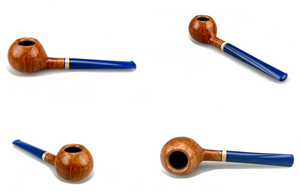
After this stage, Sauro moves onto selecting briar blocks that will best suit his chosen design, owing to the unique grain patterns each suggests. When the time comes to enter the workshop, Sauro finds it extremely useful to work on several pipes simultaneously, a tip that he picked up from his teacher Mimmo Romeo. The rationale behind this decision is that working on a single pipe at a time breeds compulsiveness and prevents the pipe maker from detaching themselves from the project:
“you learn how to make effective use of the obsessive energy that is typical of a craftsman: in compulsiveness you can no longer distinguish between ‘good’ and ‘a little less than good.’ Therefore, moving from one pipe to another becomes a way to manage this energy, to adopt a certain distance and identify more clearly the possible evolution from the original design, which is rarely as definitive as was thought at the beginning.”
When it comes to design philosophy, Sauro could be called a minimalist of sorts. He strives to produce beautiful and practical pipes that are also comprised of the least number of lines possible; he adheres to a rule that a pipe should juxtapose no more than three colors; and he rarely opts for anything but a natural stain for the stummel, opting instead for oils that enhance its native contrast effects. Coupled with this minimalism, however, is a quality of Sauro’s approach that could be called, ‘nomadic.’ While Sauro maintains a set of basic principles in designing of his pipes, the designs themselves are difficult to generalize. This is partly because, by Sauro’s account, once he has pursued and executed a design that satisfies him, it is rare that he will return to it in the pipes he makes afterwards. Sauro’s nomadism is also evident in that, when faced with a gallery of his works, one could not definitively say that these pipes lean towards, for example, an Italian, a Danish, or a German aesthetic. There are, rather, shaping conventions and motifs traditionally found in distinct locales, or within distinct workshops or schools, dispersed across Sauro’s back catalog.
Occasional Pipes and Projects
Sauro has produced a number of pipes and pipe-related creations for special occasions during his career. Pictures of these pipes can be found in the gallery below:
- Mermeid and Argonaute, a work produced in collaboration with Italian sculptor Salvatore Rizzuti in 2016.
- The Marion's Omini, a stand designed by Sauro's wife, used by Sauro for his most prestigious pipes.
- Nefertiti, a pipe whose shape and decorative band was inspired by a silhouette of the Ancient Egyptian queen. The Nefertiti is one of the few designs that Sauro has revisited several times during his career.
- The Siciliana, a pipe made for a centenary celebration of Sauro's local tobacconist, Tabaccheria Riggio, in 2019.
- Lunanera, a pipe made from larch wood for the Corones Pipe Club of Brunico 2022. According to local tradition, if wood is harvested from the larch tree during a precise time of year, during the 'black moon,' it acquires the magical property of being non-combustible.
Nomenclature and Grading
The logo found on all Sauro pipes is an outline of a wave, inspired by Hokusai’s The Great Wave off Kanagawa, along with the name, ‘SAURO’ in block capitals.
Sauro’s interest in the ‘wave’ motif is also connected to his fondness for the philosopher Laozi, for whom water, in its infinite mutability and adaptability, is a recurring symbol.
On earlier Sauro pipes, the ‘wave’ engraving was applied by hand, meaning that the logo on each pipe was always slightly different to that applied to the others. On more recent Sauro pipes, the wave logo is applied using an engraving machine.
As of 2017, Sauro pipes also include, 'handmade Italy', in cursive.
Sauro pipes do not use a grading system, which Sauro himself eschews.
Further Resources
Sauro has maintained a blog on his website since 2014, which may be of interest for anyone who wishes to further explore Sauro's work, as well as the pipe maker's occasional reflections.
Gallery
Occasional Pipes
A Selection of Other Sauro Pipes
Contact Information
Website: http://www.sauropipe.com/ Email: mailto:sauropipe@gmail.com Phone: +39 091 548300 Phone: +39 366 6200336 Via Autonomia Siciliana, 70 90143 Palermo Italy
- ↑ Biographical information was provided for this article by Gioacchino Sauro via email.
- ↑ More information about this tobacconist, as well as pictures, can be found via Riquadro at http://www.riquadro.com/ambasciatore/?ambasciatore=280 (Italian language). Sauro's own website has transcribed a 2011 article from American newspaper, L'italo-americano at https://www.sauropipe.com/en/a-special-tobacconist/ (English language).
- ↑ See https://www.pipaclubitalia.org/accademia-della-pipa/ (Italian and English language resources available).
- ↑ See https://lapipedesaintclaude.com/ (French language) for more information.
